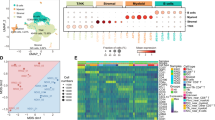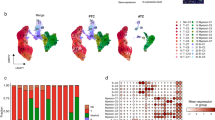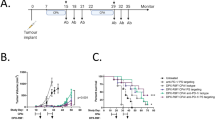Abstract
Immunization with inactivated autoreactive T cells may induce idiotype anti-idiotypic reactions to deplete autoreactive T cells, which are involved in autoimmune diseases. However, it is unknown whether attenuated activated healthy autologous T-cell immunization could increase anti-tumor immune responses. To this end, C57Bl/6 mice were immunized with attenuated activated autologous T cells. The splenocytes from immunized mice showed a higher proliferative ability than that from naive mice. The special phenotype analysis showed that there were more CD8+ T cells and CD62L+ T cells in immunized mice after 24 h of culture with 10% fetal calf serum complete medium in vitro (P<0.01). These results demonstrated that this immunization may activate T cells in vivo. Furthermore, the splenocytes from immunized mice revealed resistance to activation-induced cell death (AICD) in vitro. To further study the relative genes that are responsible for the higher proliferation and resistance to AICD, the expression of Fas/Fas ligand (FasL) and GADD45b was measured by real-time PCR. The results indicated that GADD45β transcription was higher in the splenocytes from immunized mice than that in the naive mice. In addition, the Fas expression showed a parallel higher, but FasL did not change obviously. To investigate the biologic functions induced by immunization in vivo, a tumor model was established by EL-4 tumor cell inoculation in C57/Bl mice. Mice receiving autologous T-cell immunization had significantly inhibited tumor growth in vivo (P<0.01). This study implicated that immunization with attenuated activated autologous T cells enhances anti-tumor immune responses that participate in tumor growth inhibition.
Similar content being viewed by others
Log in or create a free account to read this content
Gain free access to this article, as well as selected content from this journal and more on nature.com
or
References
Andersen MH, Pedersen LO, Becker JC, Straten PT . Identification of a cytotoxic T lymphocyte response to the apoptosis inhibitor protein surviving in cancer patients. Cancer Res 2001; 61:869–872.
Andersen MH, Pedersen LO, Capeller B, Brocker EB, Becker JC, thor Straten P . Spontaneous cytotoxic T cell responses against surviving-derived MHC class I-restricted T cell epitopes in situ as well as ex vivo in cancer patients. Cancer Res 2001; 61:5964–5968.
Cinatl Jr J, Scholz M, Doerr HW . Role of tumor cell immune escape mechanisms in cytomegalovirus-mediated oncomodulation. Med Res Rev 2005; 25:167–185.
Melchionda F, McKirdy MK, Medeiros F, Fry TJ, Mackall CL . Escape from immune surveillance does not result in tolerance to tumor-associated antigens. J Immunother 2004; 27:329–338.
Nishimura T, Iwakabe K, Sekimoto M, et al. Distinct role of antigen-specific T helper type I (Th1) and Th2 cells in tumor eradication in vivo. J Exp Med 1999; 190:617–627.
Fallarino F, Grohmann U, Bianchi R, Vacca C, Fioretti MC, Puccetti P . Th1 and Th2 cell clones to a poorly immunogenic tumor antigen initiate CD8+ T cell-dependent tumor eradication in vivo. J Immunol 2000; 165:5495–5501.
Yazawa T, Ito T, Kamma H, et al. Complicated mechanisms of class II transactivator transcription deficiency in small cell lung cancer and neuroblastoma. Am J Pathol 2002;161:291–300.
Acihini A, Maccalli C, Mortarini R, et al. Melanoma cells and normal melanocytes share antigens recognized by HLA-A2-restricted cytotoxic T cell clones from melanoma patients. J Exp Med 1993; 177:989–995.
Surman D, Dudley ME, Overwijk WW, Restifo NP . Cutting edge: CD4+ T cell control of CD8+ T cell reactivity to a model tumor antigen. J Immunol 2000; 164:562–565.
Dannull J, Su Z, Rizzieri D, et al. Enhancement of vaccine-mediated antitumor immunity in cancer patients after depletion of regulatory T cells. J Clin Invest 2005; 115:3623–3633.
Liu M, Acres B, Balloul JM, et al. Gene-based vaccines and immunotherapeutics. Proc Natl Acad Sci 2004; 101(Suppl 2):14567–14571.
Escobar A, Lopez M, Serrano A, et al. Dendritic cell immunizations alone or combined with low doses of interleukin-2 induce specific immune responses in melanoma patients. Clin Exp Immunol 2005; 142:555–568.
Hanada T, Yoshida H, Kato S, et al. Suppressor of cytokine signaling-1 is essential for suppressing dendritic cell activation and systemic autoimmunity. Immunity 2003; 19:437–450.
Schnurr M, Galambos P, Scholz C, et al. Tumor cell lysate-pulsed human dendritic cells induce a T-cell response against pancreatic carcinoma cells: an in vitro model for the assessment of tumor vaccines. Cancer Res 2001; 61:6445–6450.
Shen L, Evel-Kabler K, Strube R, Chen SY . Silencing of SOCS1 enhances antigen presentation by dendritic cells and antigen-specific anti-tumor immunity. Nat Biotechnol 2004; 22:1546–1553.
Graca L, Chen TC, Moine AL, et al. Dominant tolerance: activation thresholds for peripheral generation of regulatory T cells. Trends Immunol 2005; 26:130–135.
Peng SL . Fas (CD95)-related apoptosis and rheumatoid arthritis. Rheumatology 2006:45:26–30.
Pardo J, Bosque A, Brehm R, et al. Apoptotic pathways are selectively activated by granzyme A and/or granzyme B in CTL-mediated target cell lysis. J Cell Biol 2004; 167:457–468.
Chen SY, Yang A, Chen J, et al. Potent anti-tumor activities of a new class of tumor-specific killer cells. Nature 1997; 385:78–80.
Yang S, Haluska FG . Treatment of melanoma with 5-fluorouracil or dacarbazine in vitro sensitizes cells to antigen-specific CTL lysis through perforin/granzyme- and Fas-mediated pathways. J Immunol 2004;172:4599–4608.
Kalams SA, Walker BD . The critical need for CD4 help in maintaining effective cytotoxic T lymphocyte responses. J Exp Med 1998; 188:2199–2204.
Huang Y, Obholzer N, Fayad R, Qiao L . Turning on/off tumor-specific CTL response during progressive tumor growth. J Immunol 2005; 175:3110–3116.
Campi G, Crosti M, Consogno G, et al. CD4+ T cells from healthy subjects and colon cancer patients recognize a carcinoembryonic antigen-specific immunodominant epitope. Cancer Res 2003; 63:8481–8488.
Hajnzic TF, Kastelan M, Lukac J, Hajnzic T . Immunocompetent cells and lymphocyte reactivity to mitogens in levamisole-treated brain tumor children. Pediatr Hematol Oncol 1999;16:335–340.
Tang J, Flomenberg P, Harshyne L, et al. Glioblastoma patients exhibit circulating tumor-specific CD8+ T cells. Clin Cancer Res 2005;11:5292–5299.
Aarnoudse CA, van den Doel PB, Heemskerk B, Schrier PI . Interleukin-2-induced, melanoma-specific T cells recognize CAMEL, an unexpected translation product of LAGE-1. Int J Cancer 1999; 82:442–451.
Liu SH, Zhang M, Zhang WG . Strategies of antigen-specific T-cell-based immunotherapy for cancer. Cancer Biother Radiopharm 2005; 20:491–501.
Hong J, Zang Y, Tejada-Simon M, et al. Reactivity and regulatory properties of human anti-idiotypic antibodies induced by T cell vaccination in patients with multiple sclerosis. J Immunol 2000; 165:6858–6864.
Shapira OM, Mor E, Reshef T, et al. Prolongation of survival of rat cardiac allografts by T cell vaccination. J Clin Invest 1993; 91:388–390.
Rakhmilevich AL, Timmins JG, Janssen K, et al. Gene gun-mediated IL-12 gene therapy induces antitumor effects in the absence of toxicity: a direct comparison with systemic IL-12 protein therapy. J Immunother 1999; 22:135–144.
Kanwar JR, Shen WP, Kanwar RK, Berg RW, Krissansen GW . Effects of survivin antagonists on growth of established tumors and B7–1 immunogene therapy. J Natl Cancer Inst 2001; 93:1541–1552.
Kumar V, Sercarz E, Zhang JW, Cohen I . T cell vaccination: from basics to the clinic. Trends Immunol 2001; 22:539–544
Kozovska ME, Hong J, Zang YCQ, et al. Interferon beta induces T-helper 2 immune deviation in MS. Neurology 1999; 53:1692–1697.
Lockshin RA, Zakeri Z . Apoptosis, autophagy and more. Int J Biochem Cell Biol 2004; 36:2405–2419.
Waring P, Mullbacher A . Cell death induced by the Fas/Fas ligand pathway and its role in pathology. Immunol Cell Biol 1999; 77:312–317.
Greeneltch KM, Kelly-Welch AE, Shi Y, Keegan AD . Chronic morphine treatment promotes specific Th2 cytokine production by murine T cells in vitro via a Fas/Fas ligand-dependent mechanism. J Immunol 2005; 175:4999–5005.
Sun T, Zhou Y, Li H, et al. FASL -844C polymorphism is associated with increased activation-induced T cell death and risk of cervical cancer. J Exp Med 2005; 202:967–974.
Mallone R, Kochik SA, Reijonen H, et al. Functional avidity directs T-cell fate in autoreactive CD4+ T cells. Blood 2005; 106:2798–2805.
M Gupta, SK Gupta, AG Balliet, et al. Hematopoietic cells from Gadd45a- and Gadd45b-deficient mice are sensitized to genotoxic-stress-induced apoptosis. Oncogene 2005; 24:7170–7179.
Papa S, Zazzeroni F, Pham CG, et al. Linking JNK signaling to NF-kB: a key to survival. J Cell Sci 2004; 117:5197–5208.
Lu BF, Ferrandino AF, Flavell RA, et al. Gadd45b is important for perpetuating cognate and inflammatory signals in T cells. Nat Immunol 2004; 5:38–44.
Chi H, Lu BF, Takekawa M, Davis RJ, Flavell RA . GADD45b/GADD45c and MEKK4 comprise a genetic pathway mediating STAT4-independent IFNγ production in T cells. EMBO J 2004; 23:1576–1586.
Yang J, Zhu H, Murphy TL, et al. IL-18-stimulated GADD45 required in cytokine-induced, but not TCR-induced, IFN-γ production. Nat Immunol 2001; 2:157–164.
Mittal A, Papa S, Franzoso G, Sen RJ . NF-kB-dependent regulation of the timing of activation-induced cell death of T lymphocytes. J Immunol 2006; 176:2183–2189.
Azzzeroni F, Papa S, Algeciras-Schimnich A, et al. GADD45β– mediates the protective effects of CD40 costimulation against Fas-induced apoptosis. Blood 2003; 102:3270–3279.
Acknowledgements
This work was supported by Science and Technology Commission of Shanghai Municipality (Nos. 03DJ14009, 04DZ14902, 05ZR14055, 054319928), Shanghai Municipal Education (No. 05BZ26) and Shanghai Leading Academic Discipline Project (T0206), Translational Research Seed Fund of Institute of Health Sciences (No. XK2172).
Author information
Authors and Affiliations
Corresponding author
Rights and permissions
About this article
Cite this article
Wang, L., Du, F., Cao, Q. et al. Immunization with autologous T cells enhances in vivo anti-tumor immune responses accompanied by up-regulation of GADD45β. Cell Res 16, 702–712 (2006). https://doi.org/10.1038/sj.cr.7310083
Received:
Revised:
Accepted:
Published:
Issue date:
DOI: https://doi.org/10.1038/sj.cr.7310083
Keywords
This article is cited by
-
Involvement of P2X7 receptor signaling on regulating the differentiation of Th17 cells and type II collagen-induced arthritis in mice
Scientific Reports (2016)
-
Multi-Compartmental Vaccine Delivery System for Enhanced Immune Response to gp100 Peptide Antigen in Melanoma Immunotherapy
Pharmaceutical Research (2012)
-
Downregulation of CD4+CD25+ regulatory T cells may underlie enhanced Th1 immunity caused by immunization with activated autologous T cells
Cell Research (2007)
-
Dying T lymphocytes call for the death of tumor cells
Cell Research (2006)



